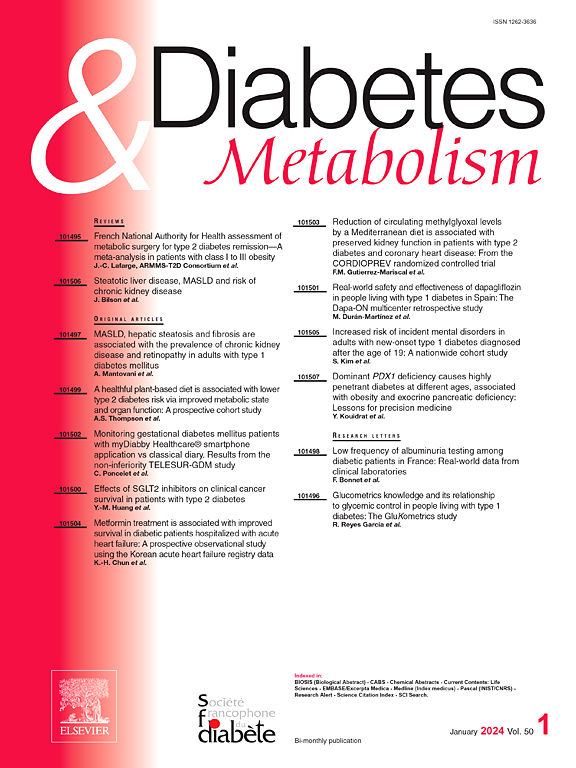Lp(a) concentration and polymorphic size are not associated with new onset diabetes in individuals with prediabetes
IF 4.7
2区 医学
Q1 ENDOCRINOLOGY & METABOLISM
引用次数: 0
Abstract
Aim
Observational studies in the general population suggest that low concentrations of lipoprotein (a) [Lp(a)] are associated with an increased risk of type 2 diabetes. Here, we aim to determine whether Lp(a) plasma concentration and Kringle-IV (K-IV) repeat polymorphism were associated with new-onset diabetes (NOD) in individuals with prediabetes.
Methods
IT-DIAB is an observational, prospective study including 303 participants with impaired fasting glucose (fasting plasma glucose [FPG]: 110–125 mg/dl) followed annually for 5 years. The primary endpoint was the development of NOD, defined as a first FPG value ≥ 126 mg/dl during follow-up. Lp(a) concentrations were measured by immunoturbidimetry, apo(a) concentrations and the number of K-IV domains by mass spectrometry. Survival analyses for NOD were modeled using Kaplan-Meier curves and a multivariable Cox model, after binarization on threshold values of Lp(a) or K-IV.
Results
Among the participants, 113 (37%) developed NOD during follow-up. The concentrations of Lp(a) and the number of K-IV domains were not significantly different according to NOD status. Similarly, the percentage of patients with a non-detectable (≤ 7 nmol/l) or elevated (>125 nmol/l) Lp(a) concentration was similar between those with or without NOD: 68.1 vs 63.7% (P = 0.46) and 8.8 vs 8.9% (P > 0.99), respectively. Kaplan-Meier curves and Cox models did not show any association between Lp(a) concentration (threshold 7 nmol/l and 125 nmol/l) or number of K-IV domain (threshold 23) and the risk of NOD.
Conclusion
In a high-risk population, Lp(a) concentration or polymorphic size do not appear to be substantially associated with type 2 diabetes risk.
在糖尿病前期个体中,Lp(a)浓度和多态性大小与新发糖尿病无关。
目的:在普通人群中的观察性研究表明,低浓度脂蛋白(a) [Lp(a)]与2型糖尿病的风险增加有关。在这里,我们的目的是确定Lp(a)血浆浓度和Kringle-IV (K-IV)重复多态性是否与糖尿病前期个体的新发糖尿病(NOD)相关。方法:IT-DIAB是一项观察性前瞻性研究,包括303名空腹血糖受损(空腹血糖[FPG]: 110-125 mg/dl)的参与者,每年随访5年。主要终点是NOD的发展,定义为随访期间首次FPG值≥126 mg/dl。免疫比浊法测定Lp(a)浓度,质谱法测定载脂蛋白(a)浓度和K-IV结构域数量。在Lp(a)或K-IV阈值二值化后,使用Kaplan-Meier曲线和多变量Cox模型对NOD的生存分析进行建模。结果:在参与者中,113例(37%)在随访期间发生NOD。不同NOD状态下Lp(a)的浓度和K-IV结构域的数量无显著差异。同样,在有或没有NOD的患者中,Lp(a)浓度不可检测(≤7 nmol/l)或升高(>125 nmol/l)的患者比例相似:分别为68.1 vs 63.7% (P = 0.46)和8.8 vs 8.9% (P > 0.99)。Kaplan-Meier曲线和Cox模型未显示Lp(a)浓度(阈值为7 nmol/l和125 nmol/l)或K-IV结构域数量(阈值为23)与NOD风险之间存在任何关联。结论:在高危人群中,Lp(a)浓度或多态性大小似乎与2型糖尿病风险无关。
本文章由计算机程序翻译,如有差异,请以英文原文为准。
求助全文
约1分钟内获得全文
求助全文
来源期刊

Diabetes & metabolism
医学-内分泌学与代谢
CiteScore
12.00
自引率
4.20%
发文量
86
审稿时长
13 days
期刊介绍:
A high quality scientific journal with an international readership
Official publication of the SFD, Diabetes & Metabolism, publishes high-quality papers by leading teams, forming a close link between hospital and research units. Diabetes & Metabolism is published in English language and is indexed in all major databases with its impact factor constantly progressing.
Diabetes & Metabolism contains original articles, short reports and comprehensive reviews.
 求助内容:
求助内容: 应助结果提醒方式:
应助结果提醒方式:


